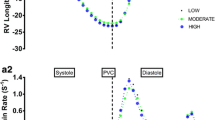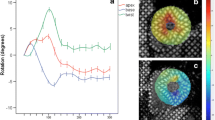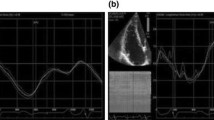Abstract
The significance and spectrum of reduced right ventricular (RV) deformation, reported in endurance athletes, is unclear. To comprehensively analyze the cardiac performance at rest of athletes, especially focusing on integrating RV size and deformation to unravel the underlying triggers of this ventricular remodelling. Hundred professional male athletes and 50 sedentary healthy males of similar age were prospectively studied. Conventional echocardiographic parameters of all four chambers were obtained, as well as 2D echo-derived strain (2DSE) in the left (LV) and in the RV free wall with separate additional analysis of the RV basal and apical segments. Left and right-sided dimensions were larger in athletes than in controls, but with a disproportionate RA enlargement. RV global strain was lower in sportsmen (−26.8 ± 2.8% vs −28.5 ± 3.4%, p < 0.001) due to a decrease in the basal segment (−22.8 ± 3.5% vs −25.8 ± 4.0%, p < 0.001) resulting in a marked gradient of deformation from the RV inlet towards the apex. By integrating size, deformation and stroke volume, we observed that the LV working conditions were similar in all sportsmen while a wider variability existed in the RV. Cardiac remodelling in athletes is more pronounced in the right heart cavities with specific regional differences within the right ventricle, but with a wide variability among individuals. The large inter-individual differences, as well as its acute and chronic relevance warrant further investigation.


Similar content being viewed by others
References
Caselli S, Di Paolo F, Psicchio C et al (2011) Three-dimensional echocardiographic characterization of the left ventricular remodelling in olympic athletes. Am J Cardiol 108:141–147
Gilbert CA, Nutter DO, Felner JM, Perkins JV, Heymsfield SB, Schlant RC (1977) Echocardiographic study of cardiac dimensions and function in the endurance-trained athlete. Am J Cardiol 40:528–533
Pluim BM, Zwinderman AH, Van der Laarse A, Van der Wall EE (2000) The athlete’s heart: a meta-analysis of cardiac structure and function. Circulation 101:336–344
Benito B, Gay-Jordi G, Serrano-Mollar A et al (2011) Cardiac arrhythmogenic remodelling in a rat model of long-term intensive exercise training. Circulation 123:13–22
Ector J, Ganame J, van der Merwe N et al (2007) Reduced right ventricular ejection fraction in endurance athletes presenting with ventricular arrhytmias: a quantitative angiographic assessment. Eur Heart J 28:345–353
Heidbüchel H, Hoogsteen J, Fagard R et al (2003) High prevalence of right ventricular involvement in endurance athletes with ventricular arrhythmias: role of an electrophysiologic study in risk stratification. Eur Heart J 24:1473–1480
La Gerche A, Burns AT, Mooney DJ et al (2012) Exercise-induced right ventricular dysfunction and structural remodelling in endurance athletes. Eur Heart J 33:998–1006
Bijnens B, Cikes M, Claus P, Sutherland G (2009) Velocity and deformation imaging for the assessment of myocardial dysfunction. Eur J Echocardiography 10:216–226
Gabrielli L, Bijnens B, Butakoff C et al (2014) Atrial functional and geometrical remodelling in highly trained male athletes: for better or worse? Eur J Appl Physiol 114:1143–1152
Rösner A, Bijnens B, Hansen M et al (2009) Left ventricular size determines tissue Doppler-derived longitudinal strain and strain rate. Eur J Echocardiogr 10:271–277
Mitchell JH, Haskell W, Snell P, Van Camp SP (2005) Task force 8: classification of sports. J Am Coll Cardiol 45:1364–1367
Lang RM, Bierig M, Devereux RB et al (2005) Recommendations for chamber quantification a report from the American Society of Echocardiography’s: guidelines and standards committee and the chamber quantification a writing group, developed in conjunction with the European Association of Echocardiography, a branch of the European Society of Cardiology. J Am Soc Echocardiogr 18:1440–1463
Dubois D, Dubois EF (1916) A formula to estimate the approximate surface area if the height and weight be known. Arch Int Med 17:863–871
Devereux RB, Alonso DR, Lutas EM et al (1986) Echocardiographic assessment of left ventricular hypertrophy: comparison to necropsy findings. Am J Cardiol 57:450–458
Mannaerts HF, van der Heide JA, Kamp O, Stoel MG, Twisk J, Visser CA (2004) Early identification of left ventricular remodelling after myocardial infarction, assessed by transthoracic 3D echocardiography. Eur Heart J 25(8):680–687
De Castro S, Pelliccia A, Casselli S et al (2006) Remodelling of the left ventricle in athlete’s heart: a three dimensional echocardiographic and magnetic resonance imaging study. Heart 92:970–976
Rudski LG, Lai W, Afilalo J et al (2010) Guidelines for the echocardiographic assessment of the right heart in adults: a report from the American Society of Echocardiography. J Am Soc Echocardiogr 23:685–713
Lang M, Badano L, Mor-Avi V et al (2015) Recommendations for cardiac chamber quantification by echocardiography in adults: an update from the American Society of Echocardiography and the European Association of Cardiovascular Imaging. J Am Soc Echocardiogr 28:1–39
La Gerche A, Robberecht C, Kuiperi C et al (2010) Lower than expected desmosomal gene mutation prevalence in endurance athletes with complex ventricular arrhythmias of right ventricular origin. Heart 96:1268–1274
Oxborough D, Sharma S, Shave R et al (2012) The right ventricle of the endurance athlete: the relationship between morphology and deformation. J Am Soc Echocardiogr 25:263–271
Teske J, Prakken H, De Boeck B et al (2009) Echocardiographic tissue deformation imaging of right ventricular systolic function in endurance athletes. Eur Heart J 30:969–977
Neilan TG, Januzzi JL, Lee-Lewandrowski E et al (2006) Myocardial injury and ventricular dysfunction related to training levels among no elite participants in the Boston marathon. Circulation 114:2325–2333
Oxborough D, Shave R, Warburton D et al (2011) Dilatation and dysfunction of the right ventricle immediately after ultraendurance exercise exploratory insights from conventional two-dimensional and speckle tracking echocardiography. Circ Cardiovasc Imaging 4:253–263
La Gerche A, Macisaac AI, Burns AT et al (2010) Pulmonary transit of agitated contrast is associated with enhanced pulmonary vascular reserve and right ventricular function during exercise. J Appl Physiol 109:1307–1317
Stefani L, Pedrizzetti G, De Lucca A, Mercuri R, Innocenti G, Galanti G (2009) Real-time evaluation of longitudinal peak systolic strain (speckle tracking measurement) in left and right ventricles of athletes. Cardiovasc Ultrasound 7:17
Wilson M, o′Hanlon R, Prasad S et al (2011) Diverse patterns of myocardial fibrosis in lifelong, veteran endurance athletes. J Appl Physiol 110:1622–1626
Jate gaonkar SR, Scholtz W, Butz T, Bogunovic N, Faber L, Horstkatte D (2009)Two-dimensional strain and strain rate imaging of the right ventricle in adult patients before and after percutaneous closure of atrial septal defects. Eur J Echocardiogr 10:499–502
Dambrauskaite V, Delcroix M, Claus P et al (2007) Regional right ventricular dysfunction in chronic pulmonary hypertension. J Am Soc Echocardiogr 20:1172–1180
Kittipovanonth M, Bellavia D, Chandrasekaran K, Villaraga HR, Abraham TP, Pelikka PA (2008) Doppler myocardial imaging for early detection of right ventricular dysfunction in patients with pulmonary hypertension. J Am Soc Echocardiogr 21:1035–1041
Vitarelli A, Sardella G, Di Roma A et al (2012) Assessment of right ventricular function by three-dimensional echocardiography and myocardial strain imaging in adult atrial septal defect before and after percutaneous closure. Int J Cardiovasc Imaging 28:1905–1916
Brili S, Stamatopoulos I, Misailidou M, Chrysohoou C et al (2013) Longitudinal strain curves in the RV free wall differ in morphology in patients with pulmonary hypertension compared to controls. Int J of Cardiol 167:2753–2756
Rondelet B, Dewachter C, Kerbaul F et al (2012) Prolonged overcirculation-induced pulmonary arterial hypertension as a cause of right ventricular failure. Eur Heart J 33:1017–1026
Funding
This work was partially funded by grants from the Fundació Clinic (premio Emili Letang, B. Merino), Generalitat de Catalunya (FI-AGAUR 2014–2017, RH 040991, M. Sanz), and from the Spanish Society of Cardiology (Fundación Española del Corazón Investigación Clínica 2012), the Spanish Government (Plan Nacional I + D + i, Ministerio de Innovación y Ciencia DEP 2011–2013 (DEP 2010–20565); Intensificación Actividad Investigadora, Instituto de Salud Carlos III (M Sitges; PI11/01709); Plan Nacional I + D, Ministerio de Economia y Competitividad DEP2013-44923-P, TIN2014-52923-R and FEDER.
Author information
Authors and Affiliations
Corresponding author
Ethics declarations
Conflict of interest
There are no conflicts of interest to be disclosed.
Additional information
Marta Sitges and Beatriz Merino equally contributed to this work and are both considered as first authors.
Electronic supplementary material
Below is the link to the electronic supplementary material.
Rights and permissions
About this article
Cite this article
Sitges, M., Merino, B., Butakoff, C. et al. Characterizing the spectrum of right ventricular remodelling in response to chronic training. Int J Cardiovasc Imaging 33, 331–339 (2017). https://doi.org/10.1007/s10554-016-1014-x
Received:
Accepted:
Published:
Issue Date:
DOI: https://doi.org/10.1007/s10554-016-1014-x




